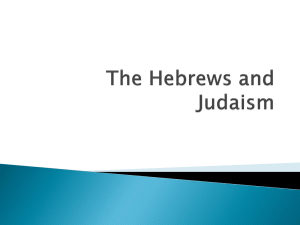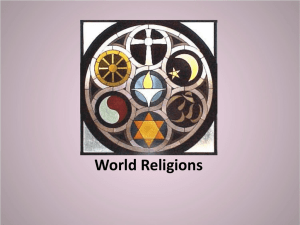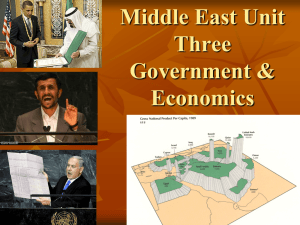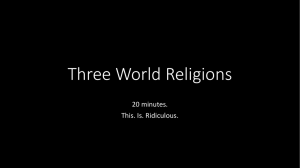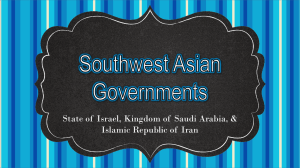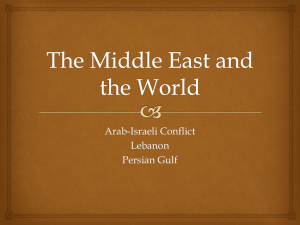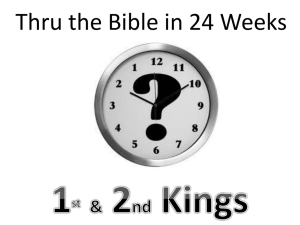Culture and Religion PPT
advertisement
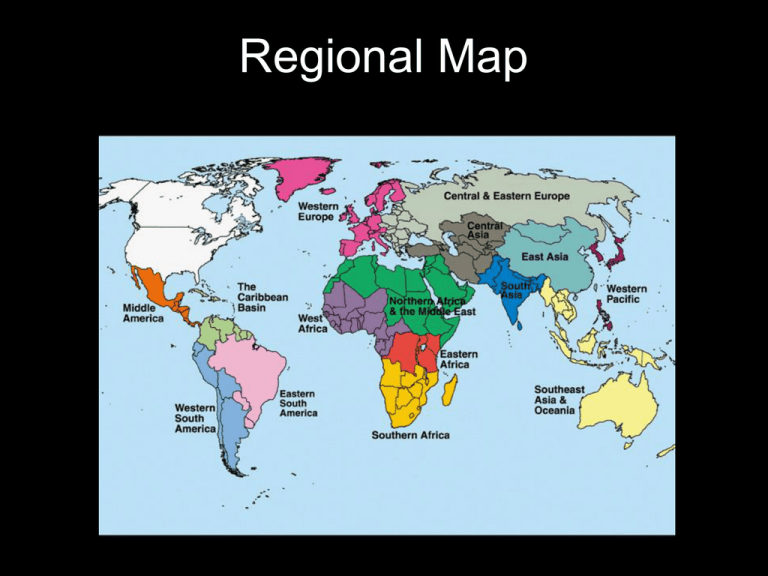
Regional Map Southwest Asia & North Africa 2 North Africa and Southwest Asia • This region is often called the Middle East. This is a term that is left over from the European colonial period and reflects a eurocentric view of the world. Why is this not right? • The correct term Southwest Asia, will be used here even though it creates problems because we tend to include China, India, and Japan. • Also, there is a problem regarding the incorporation of Saudi Arabia or Israel. Egypt is clearly more related to Syria or Iraq than those nations are to Korea or Vietnam. Geographically Egypt belongs to Africa. The nations north of the Sahara Desert share many similarities with the "Middle East" but relatively few with their neighbors in Sub-Saharan Africa. North Africa and Southwest Asia • From the political geographer's point of view, this region constitutes a shatter belt, that is, a fragmented region, coveted by outside powers, where the dangers of confrontation are great, the stakes are high, and the dangers of escalating conflict all too real. Conflict has been more or less endemic to this region throughout recorded history. Several flash points continue to persist down to the present time. • Despite its diversity, this region constitutes a unit because of: – a. the dominance of dry climates and – b. the Islamic (Moslem or Muslim) religion. Islam is the principal religion in all countries except: • Israel, where Judaism prevails; • Lebanon, where ancient forms of Christianity are of major importance. SW Asia vs. the U. S. Latitude Lines North Africa and Southwest Asia: Place and Times • The region’s history includes Fertile Crescent and Egyptian civilizations, the birth of three major religions, and the spread of Muslim empires. Ancient Mesopotamia and the Fertile Crescent • Fertile Crescent – ecologically diverse zone that stretches through the fertile hill country of northern Syria into Iraq • Region called Fertile Crescent due to its shape and the fertile soil that exists there. Water and Life: Rural Settlement Patterns • Fertile Crescent Region is early hearth of agricultural domestication • Domestication – process in which plants and animals were purposefully selected and bred for their desirable characteristics; it began in this region 10,000 years ago Pastoral Nomadism • Traditional form of subsistence agriculture based on seasonal movement of livestock • Transhumance – seasonal movement of livestock from winter to summer pastures Nomadic Lifestyles • Many people in North Africa and the Middle East still live a nomadic lifestyle. Nomads live on the Arabian peninsula and in the Sahara Desert. • Nomads usually have herds of camels or sheep and live in oases for short periods of time. A Long Urban Legacy • City life began in Mesopotamia (Eridu & Ur 3500 B.C.), and Egypt (Memphis & Thebes 3000 B.C.) • Rise of trade centers around 2000 B.C Hammurabi—ancient Mesopotamian emperor, ruled 1792–1750 B.C. • Mesopotamia—Greek for “land between the rivers” • Covers area of Iraq, parts of Syria, Turkey • A Culture Based on Writing City-States • Sumerians—first inhabitants form city-states around 3000 B.C. • City-state—city and areas it controls • Three challenges influence development of city-states: - high walls protect from hostile invaders - irrigation canals provide water to area with little rainfall - allow safe trading of grain, dates, cloth for stones, metals, timber Cuneiform •Cuneiform—one of first systems of writing, developed by Sumerians - used to write lists, records, histories, religious beliefs, science •Most Sumerians cannot write; scribes trained to keep records Ancient Egypt The civilization of the ancient Egyptians developed in response to both its desert environment and the flooding waters of the Nile River. Ancient Egypt and the Nile The River in the Sand • Greek historian Herodotus calls Egypt “the gift of the Nile” • Most of Egypt is desert, which discourages invaders - Nile is called “the river in the sand” • Egyptians, farmers plan their year around Nile flooding - but cannot predict amount of flooding each year - low floods limit crops; high floods destroy fields, homes Taming the Nile • • • • Build canals to carry water from river to dry areas Strengthen riverbanks to prevent overflow Use Nile to travel between cities; build boats, harbors, ports Nile made trade profitable, removed need for many roads The Nile’s Gifts • Nile mud used for pottery, bricks • Papyrus—paperlike material from papyrus plant found in Nile marshes The Great Builders The Pyramids • Idea of afterlife important to life, culture • Build huge temples, monuments, pyramids— four triangular sides • Pyramids built as afterlife palaces for pharaohs—kings Materials and Labor • Pyramids built with large blocks of stone, capped with gold • Builders use hieroglyphics—write with pictographs for words, sounds • All families help with dangerous work, as laborers, food providers Southwest Asia and the Birthplace of Three Major Religions • Three major monotheistic religions began in Southwest Asia. A. Judaism B. Christianity C. Islam http://www.youtube.com/watch?v=WEbSIn PEGaY Jerusalem • Jerusalem is sacred to three religions. A. Judaism - Western Wall B. Christianity - Church of the Holy Sepulchre C. Islam - Dome of the Rock Christianity • Jesus Christ was Jewish. He preached that he was the son of God. • He taught that anyone can reach salvation through faith. • His teachings were collected in the first four books of the New Testament. • He was crucified, but according to his followers he rose from the dead. Church of the Holy Sepulcher Modern Religions (Fig. 7.21) 21 Judaism Abraham and the Origin of Judaism Yahweh and Abraham • Hebrews, first monotheists, believe Yahweh spoke to Abraham - has him leave Mesopotamian Ur, settle in Canaan (now Israel) • Abraham’s descendants are Jews; religion is Judaism Judaism • Historically, Jewish people lived in the area of modern day Israel. They had a kingdom called Judea and built a temple on the temple mount in Jerusalem. • The temple held the ark of the covenant and the ten commandments. Judaism Some of the major beliefs of Judaism are: A. Monotheism - There is one god who is all powerful and all knowing. B. God made a special covenant or agreement with Abraham, who is the ‘father’ of the Jewish people. C. God revealed his laws through Moses and the Ten Commandments. Temple Mount • The temple was destroyed by the Babylonians and later rebuilt. It was destroyed again by the Romans and the only remaining section is called the Western Wall or Wailing Wall. This is a sacred place in Judaism. • (Jerusalem, 4000 years in 5 minutes) http://www.youtube.com/watch?feature= player_embedded&v=2mR2W43t6tI THE WESTERN WALL Globalization & Diversity: Rowntree, Lewis, Price, Wyckoff 26 Islam • Islam is a monotheistic religion that developed in Saudi Arabia in the early 600s. Islam is directly related to Judaism and Christianity. • Islam was founded by the Prophet Muhammed who lived from 570 to 632 in Saudi Arabia. Dome of the Rock Islam The five pillars or central teachings of Islam are: A. A statement of faith B. Prayer (five times a day in the direction of Mecca) C. Charity D. Pilgrimage to Mecca at least once in your lifetime (called the Hajj) E. Fasting (during the month of Ramadan) Islam • The teachings of Muhammed were collected into a book called the Koran. • Muslims worship in buildings called mosques. It is forbidden to make pictures or statues of Allah or Muhammed so most mosques are decorated with ornate tile work or passages from the Koran. • One of the five pillars is a pilgrimage to Mecca (or Makkah) in Saudi Arabia which was the birth place of Muhammed. Islam Early major religious split divided Islam - still exists • Shiites – current name of group that favored passing power on within Muhammad’s own family • Sunnis – current name of group that favored passing power through established clergy; emerged victorious Modern Religious Diversity • Muslims majority, except for in Israel and Cyprus • Sunni (73%); Shiites (23%) dominant in Iran, southern Iraq, Lebanon, Sudan, and Bahrain Diffusion of Islam (Fig. 7.19) THE CRUSADES A Quest for the Holy Land Crusades • A long series or Wars between Christians and Muslims • They fought over control of Jerusalem which was called the Holy Land because it was the region where Jesus had lived, preached and died Causes of the Crusades Muslim Turks captured Jerusalem from the Byzantine Empire Muslims stopped Christians from Visiting Holy Land Christian pilgrims were attacked Byzantine Empire feared attack on Constantinople The Call to Arms • Pope Urban II called for the defeat of the Turks, returning the Holy Land to the Christians Who Answered the Call? •Feudal Lords •Knights •Peasants The First Crusade (1096-1099) • Peasant army – Untrained – Lacked military equipment – Many killed by Muslim Turks • Knights – Succeeded in capturing Jerusalem Second Crusade (1147-1149) • After victory many Christians went back home. • The Turks eventually took back much of the territory. • King of France and Emperor of Germany sent troops to stop the Turks. • German and French invaders were beaten badly by a more organized Muslim defense. Second Crusade (1147-1149) Third Crusade (1189-1192) • King Richard I of England (Richard the Lionheart) fought Salah al-Din for Jerusalem • Both armies weakened by fighting • Stalemate outside city walls – peace treaty Crusades Continue Through 1200’s • Several more crusades attempted with no victories for the Christians • Children’s crusade, - 30,000 soldiers many of them under 12 years old – Never made it to the Holy Land Colonialism • The Colonial Legacy • European colonialism came late to the region – Widespread European colonialism after WWI – Many political boundaries set by colonial powers • Imposing European Power • French in Algeria since 1800, later in Tunisia, Morocco, Syria and Lebanon • Britain in Arabian Peninsula and Persian Gulf by 1900 – Suez Canal – British-engineered canal linking Mediterranean and Red seas in 1869 – British instrumental in establishing Saudi Arabia (Lawrence of Arabia) • Italians in Libya, Spanish in Morocco • Turkey, Iran (Persia) never occupied Colonialism Cultural landscape dominated by both history and colonial powers • new landscapes neo-colonial in nature • Urban & rural landscape very different • Islamic, Jewish, & Christian Symbolism creates unique and contested landscapes Colonial Influence – Italy – France – British Colonialism Legacy of Colonialism – Plantation Agriculture (particularly cotton in Sudan & Egypt) Uneven Development – Extremely Rich & Poor countries co-exist – Even within nations, such as Israel, uneven development has been devastating Uneven Resource Distribution of Natural Resources – oil producing nations have little water – nations with access to water have little in terms of ‘wealth’ producing resources Colonialism Decolonization and Independence • Europeans began to withdraw prior to WWII. • By 1950 most countries are independent • Algeria gained independence in 1962 Palestine • The central issue in the Middle East today is the conflict over Palestine. • In 1948, the United Nations partitioned Palestine into two countries, Israel a Jewish state, and Palestine, a Muslim state. Palestine Question First Aliyah sparks modern Zionist Movement when Jews escape European persecution during 1880s and settle in Palestine – 1947UN Partitions Palestine in Jewish & Palestinian Sectors – 1948 ‘War of Independence’ Unite Jewish & Arab Sectors – 1949 Jewish State Declared—Israel (1948) – 1967 ‘Six Day War’ Unite Sinai, Golan, Gaza, & West Bank – 1973 ‘Yom Kippur War’ Israel Occupies more of Sinai & Golan – 1979 Camp David Accords to return Sinai to Egypt – 1993 White House Handshake begins process of Palestinian Self Rule Palestine • Israel occupied Palestine (Gaza Strip and West Bank). In 1967, Israel occupied part of Syria called the Golan Heights after a brief war. • Palestinians are fighting for an independent country. Over the years some Palestinian groups have resorted to terrorism. Palestine • In 1993, direct negotiation between Israel and the Palestinians yielded results. – On September 12, 1993, Israel and the Palestinians signed a peace agreement, in Washington D.C. – According to these agreements, Israel and the Palestinian Liberation Organization (PLO) recognized each other’s right to exist. – In addition, the Israelis gave the Palestinians a limited autonomy in the Gaza Strip and the area surrounding the town of Jericho in the West Bank. – These agreements were implemented in May, 1994, with the transfer of power from Israeli to Palestinian control. Current Conflicts OIL!!!!! • Oil is certainly the most important resource of North Africa and southwest Asia. Deposits are concentrated around the Persian Gulf. It is the most economically important export of the realm. • During the period 1994-1996, on average, these countries together produced 28.0 percent of the world total output. • Saudi Arabia ranked as the world’s leading producer with 13.1 percent followed by: Iran with 5.8 percent; the United Arab Emirates with 3.6 percent; Kuwait with 3.3 percent; and Libya with 2.2 percent (Table 6.2). • Additional detailed statistics on the world’s leading oil countries are shown in Table 6.3. • In 1997, the world estimates in petroleum reserves were 1,160,069,500,000,000 barrels. OIL!!!!! • The Geography of Fossil Fuels • Oil unevenly distributed in the area – Saudi Arabia, Iran, U.A.E., Libya, Algeria contribute significantly to oil production, while Morocco and Sudan have few developed petroleum reserves – This region has 7% of the world’s population; holds 68% of the world’s proven petroleum reserves • Regional Economic Patterns • Higher-Income Oil Exporters – Saudi Arabia, Kuwait, Qatar, Bahrain, U.A.E. – Cultural landscape reshaped because of oil wealth – Not all benefit – rural Shiite Muslims and foreign workers Oil!!!!! • Regional Economic Patterns (cont.) – Lower-Income Oil Exporters • Algeria: oil and natural gas are its top exports; but political instability remains a problem • Iran: has huge oil reserves, but long war with Iraq (1980-90), and withdrawal from world trade under fundamentalist government have lowered living standards – Prospering Without Oil • Israel has highest living standard in the region • Turkey has a diversified economy; has seen growth Sharia Law • Body of Islamic religious law • Legal framework within which the public and some private aspects of life are regulated • There is no strictly static codified set of laws of sharia. Sharia is more of a system of how law ought to serve humanity, a consensus of the unified spirit. Rights of Women in Saudi Arabia • • • • • • • • Able to attend universities (separated from men) Work in female only occupations Can keep their own name when married Property protected Cannot drive Must wear hajib Can only marry a Muslim Can only divorce if granted by the man or approved by court • Cannot talk to men outside their family • Gained right to vote in 2004 FAQ • Do tourists or American women have to follow these laws? – In some instances. It is not necessary for women to wear hajib, but most women will take one along in order to avoid harassment by the religious police. If foreign women are accused of a crime, they are subject to similar punishments as native women. • (Jerusalem, 4000 years in 5 minutes) http://www.youtube.com/watch?feature=play er_embedded&v=2mR2W43t6tI • (Destination North Africa) http://www.watchknowlearn.org/Video.aspx? VideoID=2191&CategoryID=500 • (Rulers of the Middle East Map Progression) http://www.mapsofwar.com/ind/imperialhistory.html


